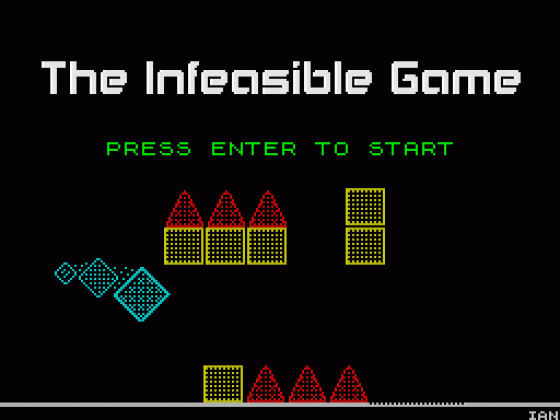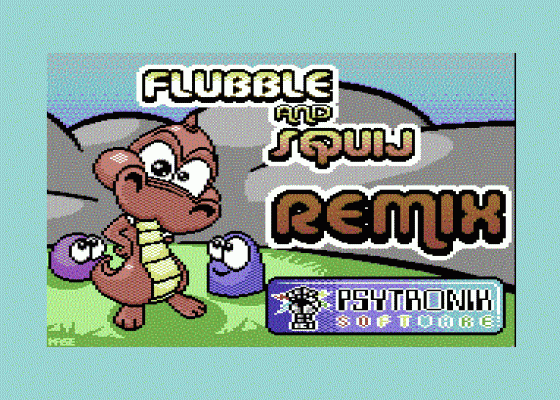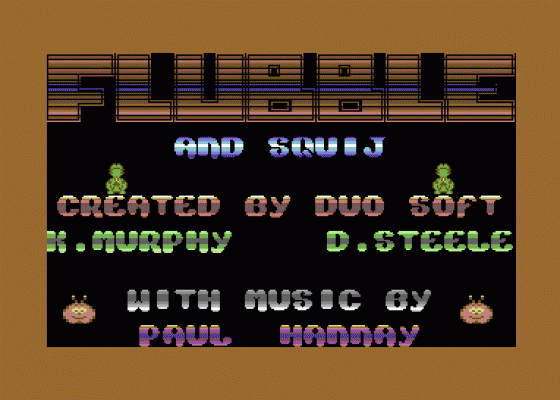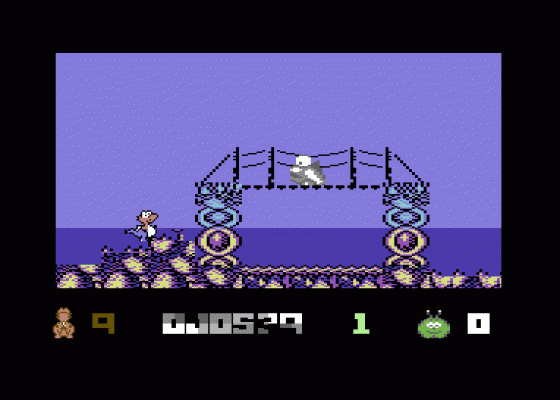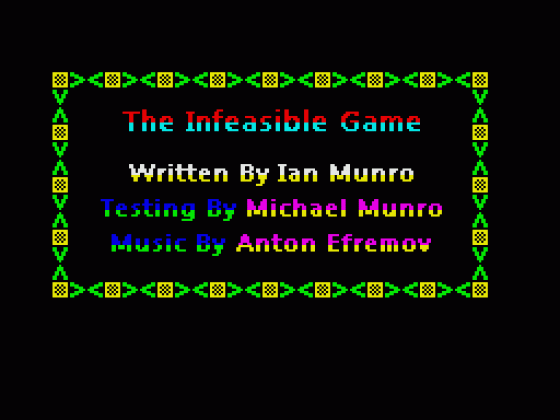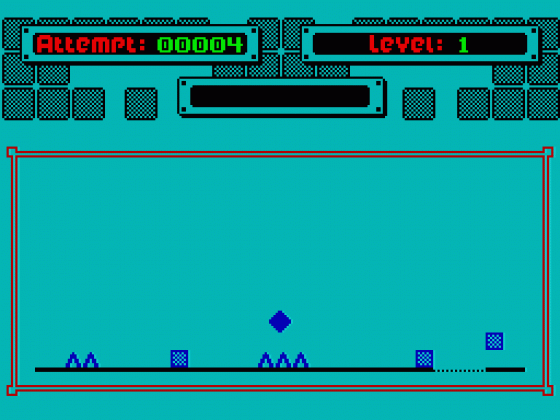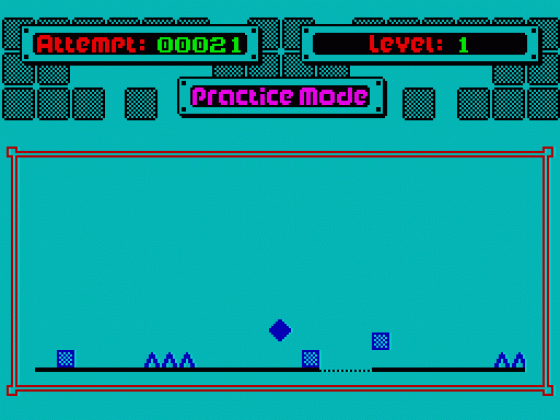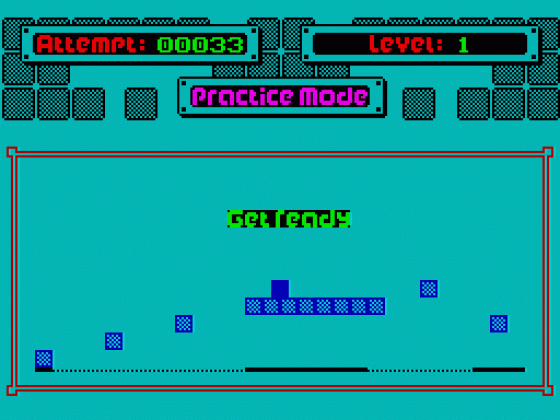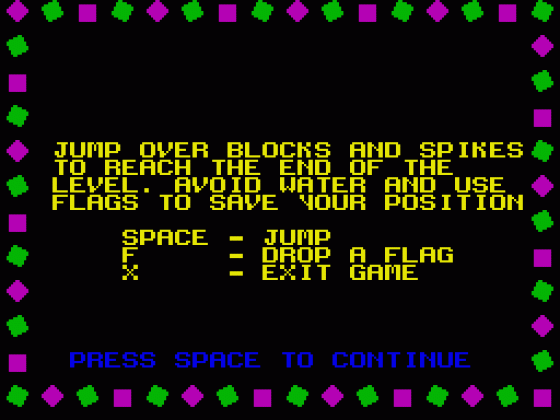
Micro Mart
 21st April 2016
21st April 2016
Categories: Review: Software
Author: Dave E
Publisher: Ian Munro
Machine: Spectrum 48K
Published in Micro Mart #1422: July 2016 Special
From the infeasible through the illogical to the magical and the downright painful, David Edwards continues his never-ending quest to promote the best new software for 80s machines, and warn us off the rest...
Welcome
Regular readers may remember that, in the earlier days of this column, I advocated investing in physical cassettes and discs for retro formats. As time has worn on however, the number of publishers producing physical versions has waned and the column has drifted more towards new games only available as emulator files.
Although there's nothing wrong with that, this month I've decided therefore to take the column back to its roots and focus on some newish games from last year's famous faces - amongst them CEZ, Psytronik and RetroWorks - who continue to supply their games not only as free downloads but also as collectible cassettes or discs. So join me as I see what creative expressions can be picked up for a fiver plus postage on-line...
Ilogicall (Spectrum 128K/ZX Vega, CEZ Games Studio, £4/Free, http://tinyurl.com/jqrrh5q)
Regular readers will recall my favourite retro game of 2015 was Pixel Quest, a puzzle game where you build up a picture on a grid by reference to a series of numbers on its horizontal and vertical axes. Apparently, these "nanogram" games have existed for years and I am in the minority having not experienced the joys of such pixel-plotting before.
Ilogicall is the same type of game. You get a blank grid, typically 16x16 characters, and must look at the numbers to determine whether you can safely "mark" individual rows and columns in compliance with what they say, but without disturbing the combination required by the opposite axis. The grids begin easily enough, with columns simply stating 16 meaning each square in it should be "marked", and row combinations such as 2128 (XX.X.XX.XXXXXXXX). They do however start to toughen up after level four.
So far then, so identical to Pixel Quest. Indeed, there's really only one big difference between the two games. The difference is what happens when you make a mistake, either carelessly or recklessly. Ilogicall's grids have a thirty minute time limit. Very generous, until you realise that "marking" a single square wrongly incurs a five minute time penalty. The implication of this is that you can afford to make a maximum of roughly five mistakes per grid before your time will be up. Pixel Quest has no such limitation, each grid took you as long as it took and, on successful completion, a brand new one was presented.
What is quite interesting about a "timed" version of Pixel Quest is that being thwarted by your own carelessness does actually mean you don't find you've lost several hours playing it non-stop. Being thrown back to the title page and having to start again breaks your intense concentration and results in Ilogicall being slightly less addictive. It is however, more challenging.
Overall then, despite having been (mostly) done before, there is just enough of a change to the nanogram formula that this should be added to your games collection. Competently programmed with a superb loader and in-game music, it will also likely make this year's favourites too.
Available to buy on limited edition cassette from Computer Emuzone (computeremuzone.com), preloaded on the ZX Vega or available to download for free from Everygamegoing at http://tinyurl.com/jqrrh5q
Scores (Illogical)
Graphics 50%
Sound 85%
Playability 90%
Value For Money 80%
Overall 76%
Flubble And Squij (Psytronik, Commodore 64, £4.99, http://tinyurl.com/zmtwdgh)
Flubble And Squij is a tricky platformer which is currently available from Psytronik for the Commodore 64. It comes in two versions which offer similar game mechanics but very different sprites. For the sake of ease, this review is of the "Remix" version.
You play Flubble, a dragon-like character, controlled with the joystick. Pushing up will jump and pulling down will teleport - whenever you position him over a pipeline. As is the usual fare of platformers, the platforms are patrolled by aliens intent on colliding with you and taking away one of your precious lives. To combat them you can press the fire button, which puts Flubble into a "tail-spin" and causes him to despatch aliens he collides with.
The good news about the tail-spin is that it is remarkably effective. The bad news is that it's a very odd effect to behold - your dragon spins through 360 degrees rather like many platform characters do just before death!
Indeed, Flubble seems to mess about with quite a few of the more "tried and tested" inclusions of classic platformers like Super Mario (NES) or Crazy Sue (Amiga). Amazingly, the fact that the fire button doesn't jump your dragon, or produce some sort of bullets, means that, until you read the instructions, it's not immediately obvious what to do in the game at all.
The aim is, however, to collect the Squij characters, and a handy counter of those remaining is shown at the bottom right of the screen. So, guided by the illustrated Squij at the bottom-right, and armed with the ever-powerful tail-spin, off you set on your mission.
The screen scrolls right only, and at a steady pace, keeping Flubble in the middle of it at all times. Jumping is easily controlled, and your only real worry is that, after tail-spinning, Flibble takes a few seconds to recover. Nine times out of ten this is no problem at all as you will have already bounded into all the aliens you wanted to despatch and his recovery period gives you a nice breather. On other occasions, you may have wiped out all the enemies you could see but you may, in your exuberance, have pushed the screen so far to the right that another enemy is now making his way toward you.
The choice of alien sprites, the right only scroll, the pipelines at the bottom of the screen and the jumping effect give Flubble And Squij a very similar feel to Super Mario. Unlike that classic, there's no timer to contend with and a certain amount of mental mapping is required to determine where the Squijs can be found.
And this is really where the game falls down. Firstly, looking at the illustrated Squij screen right leads you to suspect you need to find cutesy, green jellyfish - but actually some Squijs appear quite differently, hanging upside down, or appearing in cyan instead of green. Secondly, the teleporters (pipelines) usually teleport you backwards rather than to a wholly new area. It gets very frustrating trying to remember which Squijs you've collected already... and accidentally teleporting right back to the very beginning would be frustrating enough in itself - but when you also realise teleporting reincarnates all previously-killed aliens, it's almost enough to cause you to have the type of tantrum you hoped you had grown out of!
The game has eight screens and is available on both tape and 5.25" disc. It's actually the type of game that may grow upon you with practice - there are inclusions like mushrooms that inject a bit of variety to the travails. However, in their regard I have to sound a note of caution - shortly after I collected one, the game appeared to completely crash, causing Flibble to teleport uncontrollably every few seconds (and whilst being nowhere near a pipeline).
Hey ho. In summary then, an excellently executed, cartoony platformer but one which, even in its "remixed" form seems slightly rough around the edges. Flubble And Squij is available from Psytronik (www.psytronik.net).
Scores (Flubble And Squij)
Graphics 82%
Sound 83%
Playability 67%
Value For Money 70%
Overall 76%
Black Horse (Spectrum 48K/128K, RetroWorks, £4.99, http://tinyurl.com/zzbm3vc)
I'm far from being a great chess player - learning how to play it well takes a degree of study that I don't have the time for. However, I do know how all (Well, most!) of the pieces move, which is useful if you're interested in Black Horse, a new Spectrum game from Digital Brains.
Starting the game draws a superior isometric 3D grid with your piece, the black knight, positioned on one of the squares within it. The grids are essentially "cut outs" of a chessboard with the familiar white and black chequered pattern. What's different is that the grids aren't square. Instead they have the look of jigsaw pieces, with sections that jut out in different directions.
The aim of each grid is to collect the "star" token by manoeuvring your knight, who can only move like a regular knight chess piece, onto it. You start on a grid where collecting the star is easily done and progress through grids which introduce ever more features and enemy chess pieces.
Whether you like chess or not, the game is a good puzzler, and it has plenty of variety whilst being extremely intuitive to play. Full instructions are included, and displayed before the game starts, but it's programmed so well that you're unlikely to need them. Perhaps the most important thing to point out is that, as you progress, it gets much easier to die. The enemy chess pieces behave in different ways depending on which grid you are attempting, and this can catch you off guard. For example, the King can only move one square in any direction, which means your Knight can quickly outsmart him by moving so that a clear way to the star is opened, either with or without removing him from the board. You move, then he moves and, assuming you're still alive, you rinse and repeat.
However, on later grids the enemy chess pieces do not move after you do. Rather, they lie in wait until you place the knight on a square that they can legally move to. Watching how (or if!) enemy pieces move after you make your first move will give a useful indicator of the strategy any particular grid will need. You have five lives to get as far as you can.
It's hard to get too excited (if you're me) about chess but I would imagine there's a ready-made market of Black Horse players - essentially it's a cross between chess and Ultimate's Alien-8 and, although it may be a puzzler at heart, the presence of the enemy pieces additionally introduces a competitive edge. You won't find the Spectrum "thinking" for 60 seconds either - it moves its pieces instantly!
Black Horse is available from Retro Works on limited edition cassette for £4.99 or download free from Everygamegoing (http://tinyurl.com/zzbm3vc).
Scores (Black Horse)
Graphics 73%
Sound 60%
Playability 85%
Value For Money 60%
Overall 70%
The Infeasible Game (Spectrum 48K/128K, Ian Munro, Free, http://tinyurl.com/hxao9z5)
Although Cronosoft is still selling new games for old formats, it has been uncharacteristically quiet as of late. Its Facebook page however did direct me to by Ian Shape Shifter Munro's latest Spectrum game. Called The Infeasible Game, it's an extremely smooth-scrolling platformer. All done in monochrome, and featuring the type of graphics that could've been designed on graph paper, it regrettably has much of the appearance of an Eighties type-in. Fortunately, there is a lot more to be said regarding playability.
You control an 8x8 chr$ box and, after a quick pause to "Get Ready", begins to scroll with the screen. You'll find you need to press the space bar to "jump" - so that your box isn't propelled straight into spikes, or flies off the edge of the platform on which you're travelling. Jumping flips your box in a surprisingly-spectacular arc - just the thing to either avoid those spikes, leap over a gap in the platform or, indeed, leap from the edge of one platform up to the start of another.
If you're familiar with Flappy Bird, then The Infeasible Game is a close cousin in terms of being a "one-way only pseudo reaction test" of a game. The skill is in not coming to a sticky end - such end sends you right back to the beginning for another attempt! - but, whilst in Flappy Bird the aim was to keep your bird airborne and flying through the randomly scrolling gaps in the landscape of pipes, here it's not only about how long you survive but also how well you can remember the sheet itself.
As in Flappy Bird, you end up colliding with scenery a lot. Your biggest peril is the spikes but even the innocent-looking platforms themselves are hazardous if you don't land on them correctly. Hence, to assist you in getting further in the game, and to prevent reducing you into a gibbering wreck within five minutes flat, you can save your position at any point in your trek over the platforms by dropping a flag. If you're familiar with emulator save states, then you'll quickly cotton on to this technique. Drop a flag then die - as you surely will - and you'll return to the position when the flag was deposited, not the very beginning of the sheet.
Alas, dropping even a single flag turns your entire attempt at the sheet into a "practice run". You may indeed reach the end, but it won't count for anything except to help you memorize the sheet for a "real" run, which must be completed without dropping a single flag.
Infeasible by name and infeasible by nature, it's not particularly impressive as a game concept. Firstly, as its name suggests, you're extremely unlikely to make it across even the first sheet without having to use the flags. Secondly, a big problem with using those flags is that you can drop one of them just before careering into a pit of spikes... and then get caught in an ever-repeating death loop. If so, the only option is to quit and start again. That's hardly encouraging stuff.
Nevertheless, The Infeasible Game handles well and there's a pulse-pounding piece of music in the background that lifts the gaming experience. There's also at least one disorienting inclusion on the very first sheet - just as you're getting the hang of it, the playing area suddenly turns upside down! There may well be further unexpected, and different, phenomena on subsequent sheets too. But it will be a very brave, and I suspect masochistic, player who ever sticks with the game long enough to see them.
Scores (The Infeasible Game)
Graphics 10%
Sound 85%
Playability 40%
Overall 45%
The Adventures Of Amy Concave (Amstrad CPC, Ego-Trip, Free, http://tinyurl.com/jscewy9)
This Amstrad game by Ego-Trip is actually the prequel to Jewel Warehouse, and features the same heroine, Amy, on a quest for crystals in a bunch of caverns. Unlike Jewel Warehouse though, it's awful.
First to the instructions. As seems depressingly normal in the Amstrad world, it doesn't come with any. I'm tired of labouring this point in reviews by now so let's just give it its first black mark and move swifty on.
Next, it's joystick only which, quite obviously, means you can't play it without one. Now practically everyone plays Amstrad games via the WinApe emulator on their PC these days and, considering you can emulate a joystick through your PC's keyboard, this might not be too limiting - were not mapping those keys fiddly and time-consuming. Add this on to not knowing how to play and you may wonder why you're bothering - before you've even moved Amy across a single screen!
Amy Concave is a platform game and it employs an energy bar in the shape of a heart. This is depleted in quarters if you collide with spikes or a patrolling nasty. Regrettably, the collision detection is ridiculous, particularly in relation to stationary obstacles. Completely clearing them still eats up big chunks of your heart... and if you jump into a door for which you haven't collected a key, instead of bouncing off it as you might expect, you are instantly killed! There's also a very noticeable, and quite disconcerting, "recalculation" of your lives and energy bar whenever you change room.
Dark red as a background colour is a very odd choice and, to conclude, there's no sound at all apart from a scale of notes whenever you jump and a buzz when you lose some energy.
Now that is a long list of complaints. Indeed, I racked my brains in the hope of finding some reason - any reason - to advise anyone to play it. Alas, I came up with none. As the game was written with an arcade adventuring tool, about the best crumb of comfort I can offer Ego-Trip is to say it might be terrible due to the limitations of this tool rather than the programming skills of its author.
Amy does react well to controls and the game itself does have a nice Opener and Game Over sequence. And, of course, I have seen a lot worse.
It's a shame that the Amstrad is being somewhat neglected at the moment but you'd have to be pretty desperate for a new game for it to even consider giving this a go.
Scores (The Adventures Of Amy Concave)
Graphics 25%
Sound 5%
Playability 30%
Overall 20%
And That's It!
I'm sure you'll agree that either I'm getting harder to impress or this month wasn't a vintage one. But don't be disheartened (even if you are an Amstrad owner). I have it on good authority that entries are flooding in for the Amstrad CPCRetroDev competition... See you next month!
Other Reviews Of The Infeasible Game For The Spectrum 48K
The Infeasible Game (Ian Munro)
A review by Dave E (Everygamegoing)

